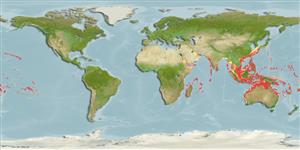Classification / Names
Common names from other countries
Main reference
Size / Weight / Age
Max length : 40.0 cm TL male/unsexed; (Ref. 5222); common length : 22.0 cm TL male/unsexed; (Ref. 5450); max. published weight: 2.0 kg (Ref. 30874)
Length at first maturity
Lm ?, range 16 - ? cm
Environment
Marine; brackish; reef-associated; depth range 4 - 160 m (Ref. 5222), usually 20 - 45 m (Ref. 5222)
Climate / Range
Tropical, preferred 28°C (Ref. 107945); 36°N - 35°S, 22°E - 124°W
Distribution
Short description
Dorsal
spines
(total): 11;
Dorsal
soft rays
(total): 15-17;
Anal
spines: 3;
Anal
soft rays: 8. Distinguished by having color ranging from pale greenish grey to pale reddish yellow or pinkish; with 5-6 dark bars of variable intensity; top of head reddish brown; ctenoid scales on body except cycloid anterodorsally above lateral line and on thorax and ventrally on abdomen; body with numerous auxiliary scales; greatest body depth 2.8-3.3 in SL; rounded caudal fin; pelvic fins 2.0-2.4 in head length (Ref. 90102); characterized further by having flat interorbital area, convex dorsal head profile; snout length contained 4.3-5.1 times in HL; rounded preopercle, finely serrate rear edge, with lower most serrae slightly enlarged; upper edge of operculum straight; subequal posterior and anterior nostrils; maxilla reaches to below rear third of eye or a little past eye; 2-4 rows of teeth on midlateral part of lower jaw (Ref. 89707).
IUCN Red List Status (Ref. 115185)
Threat to humans
Reports of ciguatera poisoning (Ref. 30298)
Human uses
Fisheries: commercial; gamefish: yes; aquarium: commercial
Tools
Special reports
Download XML
Internet sources
Estimates of some properties based on models
Phylogenetic diversity index
PD50 = 0.5000 many relatives (e.g. carps) 0.5 - 2.0 few relatives (e.g. lungfishes)
Trophic Level
3.7 ±0.4 se; Based on diet studies.
Resilience
Low, minimum population doubling time 4.5 - 14 years (K=0.16)
Vulnerability
Moderate to high vulnerability (53 of 100)
Price category
